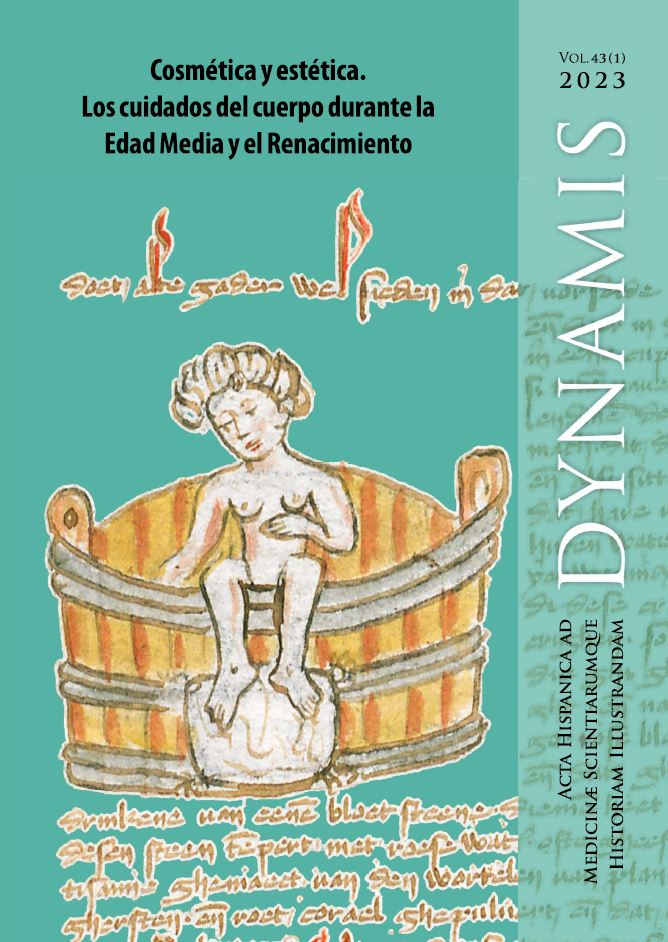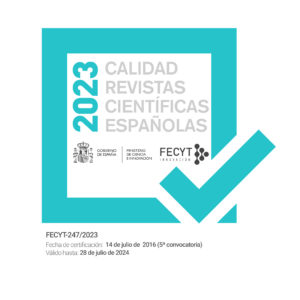In Pursuit of Beauty: Facial and hair care in the Hebrew textual corpus of medicine
DOI:
https://doi.org/10.30827/dynamis.v43i1.28965Keywords:
Hebrew medicine, adornment of the body, recipe books, medical books, loose recipesAbstract
This paper presents the preliminary results of ongoing research into three Hebrew textual genres or typologies that have cosmetic content and have been little studied to date, including recipe books, general medical books, and loose recipes. The analysis focused on recipes and procedures that deal with care of the face and hair, about which all show a striking concern. On one hand, we examine the various purposes of the recipes and describe the ingredients, techniques, and procedures. On the other, we examine how cosmetic knowledge and techniques are articulated in different medical contexts, which are not always apparently aimed at women’s health but take place within discourses of sexual difference and at the intersection of gender, class, and ethnicity.
Downloads
References
Abú-l-Walíd Ibn Rušd, El libro de las generalidades de la medicina [Kitáb al-Kulliyyát f íl- tibb] Abú-l-Walíd Ibn Rušd (Averroes), edited and translated by M. Concepción Vázquez de Benito and Camilo Álvarez Morales. Madrid: Editorial Trotta, 2003.
Adams, Stevens. “Male Body Hair Depilation in Jewish Law.” Ḥakirah, the Flatbush Journal of Jewish Law and Thought , no. 29 (2021): 197-231.
Barkai, Ron. Les infortunes de Dinah, ou la gynécologie juive au moyen âge. Paris: Cerf, 1991. Barkai, Ron. A History of Jewish Gynaecological Texts in the Middle Ages. Leiden: Brill, 1998. Blasco Orellana, Meritxell. “Notas sobre ginecología y cosmética femenina (el manuscrito médico hebraico: Ms. Firkovitch HEB I 340 de la Biblioteca Nacional de Rusia).” El Prezente, no. 3 (2009): 97-111.
Blasco Orellana, Meritxell. Recetario médico hebraicocatalán del siglo XIV. Barcelona: PPU, 2015.
Caballero Navas, Carmen. El libro de amor de mujeres. Granada: Universidad de Granada, 2003.
Caballero Navas, Carmen. “Algunos ‘secretos de mujeres’ revelados. El Še’ar yašub y la recepción y transmisión del Trotula en hebreo.” Miscelánea de Estudios Árabes y Hebraicos. Sección Hebreo, no. 55 (2006): 381-425.
Caballero Navas, Carmen. “Mujeres, cuerpos y literatura médica en hebreo.” Asclepio, no. 60 (2008): 37-61, https://doi.org/10.3989/asclepio.2008.v60.i1.243 DOI: https://doi.org/10.3989/asclepio.2008.v60.i1.243
Caballero Navas, Carmen. “The Care of Women’s Health: An Experience Shared by Medie- val Jewish and Christian Women.” Journal of Medieval History, no. 34/2 (2008): 146-163, https://doi.org/10.1016/j.jmedhist.2008.03.007 DOI: https://doi.org/10.1016/j.jmedhist.2008.03.007
Caballero Navas, Carmen. “Medicine among Medieval Jews: The Science, the Art, and the Practice.” In Science in Medieval Jewish Cultures, edited by Gad Freudenthal, 320-342. Cambridge: Cambridge University Press, 2011. DOI: https://doi.org/10.1017/CBO9780511976575.021
Caballero Navas, Carmen. “The Genesis of Medieval Hebrew Gynaecology: A Prelimi- nary Assessment.” In Defining Jewish Medicine. Transfer of Medical Knowledge in Jewish Cultures and Traditions, edited by Lennart Lehmhaus, 349-373. Wiesbaden: Harrassowitz, 2021. https://doi.org/10.13173/9783447108263.349 DOI: https://doi.org/10.13173/9783447108263.349
Cabré, Montserrat. “Autoras sin nombre, autoridad femenina (s. XIII).” In Las sabias mujeres II (siglos III–XVI). Homenaje a Lola Luna, edited by M.M. Graña, 59-73. Madrid, 1995.
Cabré, Montserrat. La cura del cos femení i la medicina medieval de tradició llatina els tractats “De ornatu” i “De decorationibus mulierum” atribuïts a Arnau de Vilanova, “Tròtula” de mestre Joan, i “Flos del tresor de beutat”, atribuït a Manuel Díeç de Calatayud. Barcelona: Publicacions Universitat de Barcelona, 1996.
Cabré, Montserrat. “From a master to a Laywoman: A Feminine Manual of Self-Help.” Dynamis, no. 20 (2000): 371-393.
Cabré, Montserrat. “Cosmética y perfumería en la Castilla bajomedieval.” In Historia de la ciencia y de la técnica en la Corona de Castilla Vol. II. Edad Media, dir. Luís García-Ballester, 772-779. Valladolid: Junta de Castilla y León, 2002.
Cabré, Montserrat. “Cosmetics.” In Women and Gender in Medieval Europe: an Encyclo- pedia, edited by Margaret Schaus, 173-174. New York: Routledge, 2006.
Cabré, Montserrat. “Los consejos para hermosear (“libros” I-III) en el Regalo de la Vida Humana de Juan Vallés.” In Juan Vallés, Regalo de la Vida Humana, coord. by Fernando Serrano Layoz,171-202. Pamplona, Gobierno de Navarra, 2008.
Cabré, Montserrat. “Keeping Beauty Secrets in Early Modern Iberia.” In Secrets and Knowledge in Medicine and Science, 1500–1800, edited by Elaine Leong and Alisha Rankin, 167-190. Farnham, UK: Ashgate, 2011.
Dayagi-Mendels, Michal. Perfumes and Cosmetics in the Ancient World. Jerusalem: Israel Museum, 1989.
Dioscórides, Plantas y remedios medicinales: De materia medica. Madrid: Gredos, 1998. Faraudo Lluís, Vocabulari de la llengua catalana medieval de Lluís Faraudo de Sant-Germain. Institut d’Estudis Catalans. http: //www.iecat.net/faraudo/
Font Quer, Pío. Plantas medicinales: el Dioscórides renovado. Barcelona: Península, 1999. Freudenthal, Gad, Michael McVaugh and Katelyn Mesler, “Twelfth-Century Latin Medi- cine in Hebrew Garb: Doeg the Edomite as a Cultural Intermediary.” Medieval Encounters, no. 26/3 (2020): 226-284. DOI: https://doi.org/10.1163/15700674-12340072
Friedman, John Block. “Eyebrows, Hairlines, and “Hairs Less in Sight”: Female Depilation in Late Medieval Europe.” In Medieval Clothing and Textiles, edited by Robin Netherton and Gale R. Owen-Crocker, vol. 14, 81-111. Woodbridge: The Boydell Press, 2018. DOI: https://doi.org/10.1017/9781787442443.005
Green, Monica. The Trotula. A Medieval Compendium of Women’s Medicine. Philadelphia: University of Pennsylvania Press, 2001. DOI: https://doi.org/10.9783/9780812204698
Hamarneh, Sami. “The First Known Independent Treatise on Cosmetology in Spain.” Bulletin of the History of Medicine, no. 39/4 (1965): 309-325.
Herrera, M. Teresa. Diccionario español de textos médicos antiguos, 2 vols. Madrid: Arco Libros, 1996.
Khune Brabant, Rosa. “ ‘Zinā e islah’: Reflexiones para entender la medicina estética del joven Abū Marwān b. Zuhr (ob. 1161/2).” Al-Andalus Magreb, no. 4 (1996): 281-298. Labovitz, Gail. “Even Your Mother and Your Mother’s Mother”: Rabbinic Literature on Women’s Usage of Cosmetics.” Nashim, no. 23 (2012): 12-34, https://doi.org/10.2979/nashim.23.12 DOI: https://doi.org/10.2979/nashim.23.12
Leibowitz, O. and S. Marcus (eds.). Sefer Hanisyonot. The Book of Medical Experiences Attributed to Abraham ibn Ezra. Jerusalem: Magnes Press, 1984.
Recopilación de recetas cosméticas. Biblioteca Palatina de Parma, Cod. Parm. 2293. ff. 6a y 6v. Richler, Benjamin. Hebrew Manuscripts in the Biblioteca Palatina in Parma. Catalogue. Jerusalem: Jewish National and University Library, 2001.
Sefer ha-yosher. Oxford, Bodleian Library Ms. Oppenheim 180, ff. 1r-87r; Oxford, Bodleian Library Ms. Oppenheim 181, ff. 1r-48r; Viena, Oesterreischische Nationalbibliothek Cod hebr. 64/1, ff. 2r-124r. Sefer ya’ir natib. Oxford, Bodleian, Ms. Can. Or. 26, ff. 216r-305.
Valverde, José Luis y Carmen Peña Muñoz. El formulario de los hospitales de Ibn Abil Bayan. Introducción, traducción Española y comentarios, con glosarios. Granada: Universidad de Granada, 1981.
Downloads
Published
How to Cite
Issue
Section
License

This work is licensed under a Creative Commons Attribution-NonCommercial-NoDerivatives 4.0 International License.
Dynamis se encuentra adherida a una licencia Creative Commons Reconocimiento (by), la cual permite cualquier explotación de la obra, incluyendo una finalidad comercial, así como la creación de obras derivadas, la distribución de las cuales también está permitida sin ninguna restricción.

















